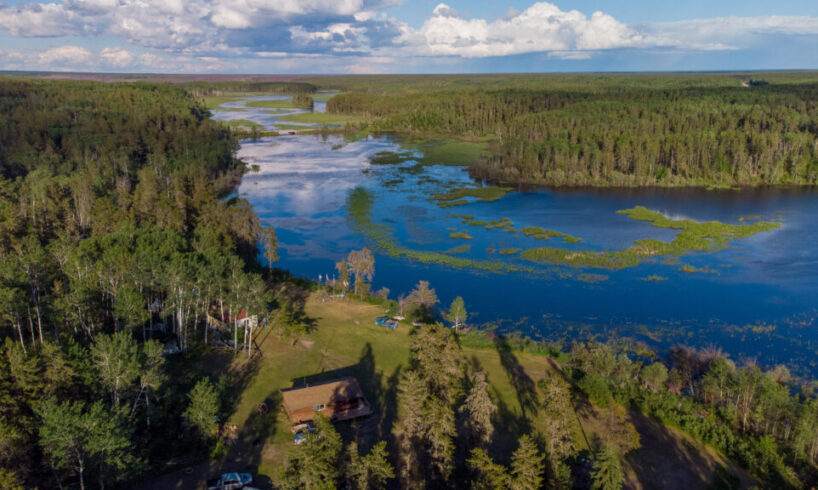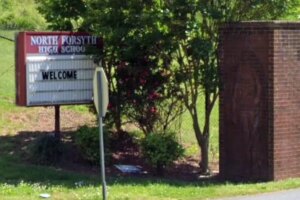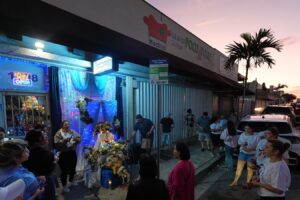
Recent wildfires in northern Saskatchewan have wiped out 90 per cent of a proposed Indigenous Protected and Conserved Area, according to residents and workers. The damage includes areas of both cultural and ecological significance for the Métis community, including caribou habitat and harvesting areas.
Île-à-la-Crosse is one of the oldest communities in Western Canada, interim Mayor Vince Ahenakew says, founded 250 years ago next year. Over generations, the Métis community developed deep relationships with the boreal forest, passing down the traditions of hunting and trapping.
In 2019, the community received federal funding to explore the possibility of creating an Indigenous Protected and Conserved Area in the N-14 Fur Block, a 22,000 square kilometre region of their territory — around four times the size of Prince Edward Island. They called it Sakitawak, after the Cree name for Île-à-la-Crosse, which means “the place where the river flows out.” But in 2022, federal funding lapsed, and in the summer of 2023, wildfire devoured half of the proposed protected area. Now, Ahenakew tells The Narwhal, another devastating wildfire season has burned nearly everything that was left.
Today, the Métis Nation-Saskatchewan issued a state of emergency in what’s known as Northern Region III, which encompasses Île-à-la-Crosse.
“We are witnessing the destruction of traplines, harvesting areas, traditional medicines and critical habitats — the very foundations of our way of life. These are not just environmental losses; they are direct threats to our section 35 rights under the Constitution. This is not only an environmental crisis — it is a constitutional and cultural emergency,” Brennan Merasty, minister of self-determination and self-government for Métis Nation-Saskatchewan, said in a statement.
Key areas in proposed conservation area have been lost to wildfires
After more than a year without federal funding, Sakitawak received three years of funding in 2023 through the Indigenous-led area-based conservation fund, which was awarded to the Metis Nation-Saskatchewan.
Official estimates for the area burned this summer are not yet available from the province, but Ahenakew estimates only around ten per cent of the proposed protected area — home to a number of vulnerable species, including endangered piping plovers and threatened woodland caribou — has escaped the fires.
A key area covered by the Sakitawak Indigenous protected area is Kazan Lake, home to bird species including American white pelicans, double-crested cormorants, ospreys and great blue herons; it burnt in the 2023 fires, Joanne, program director for Sakitawak, told The Narwhal by email.
Ahenakew worries about the hunters and trappers in his community. “That’ll be a big impact,” he says. “The youth want to try trapping, but there might not be enough for them.”
As for the woodland caribou, he says, “Most of their habitat in the Pine River region is gone.” According to Kent,, Pine River is another key area covered by the protected area. It’s not only a calving ground for the caribou, but also the only source for a traditional medicinal plant, which has been lost to fire. “It was the last remaining old-growth forest that the [proposed protected area] had left,” Kent wrote to The Narwhal by email. “It will take 70 years for the forest to regrow and for some animals and plants to return.” Meanwhile, the fires are still burning.
When it was proposed in 2019, Sakitawak was a canopy of wetlands and boreal forest. Now, residents and workers say that nearly all of it has been lost to wildfire. Photo: Jeremy Williams / River Voices Productions
2025 wildfire season worse than average in Saskatchewan
According to the Government of Saskatchewan, as of July 22 there were 50 active wildfires burning across the province, and 384 this year so far — well above the annual average of 260. Eleven communities are currently under evacuation orders, including Île-à-la-Crosse.
Wildfire is a natural phenomenon, and Ahenakew remembers the forests of Sakitawak burning 20 years ago. But hotter, drier conditions are changing wildfire behaviour, causing fires to recur in the same areas more frequently. Lori Daniels, a professor of forest ecology at the University of British Columbia, told The Narwhal in 2023 that in some regions, forest landscapes are not regenerating — instead, they’re turning into shrub lands or tundra.
When it was proposed as a protected area, Sakitawak was estimated to store around 839 million tonnes of carbon, and Canada’s 552 million hectares of boreal forest is a critical carbon sink for the planet. But Daniels told The Narwhal in 2023 that wildfires have changed the equation, saying, “In truth, our forests have been a net emitter of carbon because of insects and pathogens and wildfire for the last decade and a half, or two decades now.”
Sakitawak receives federal support, but wildfires impede activities
While three other proposed Indigenous Protected and Conserved Areas in Saskatchewan have received federal support through the same fund, none have yet been recognized by the province. Provincial buy-in is key for advancing Indigenous-led conservation initiatives, but support from provincial governments varies across Canada. (The provincial Ministry of Environment declined to answer a question from The Narwhal regarding whether it plans to recognize Indigenous-led conservation efforts in the province.)
Kent says there are currently five full-time staff and three summer students who work as Guardians. Collecting baseline data on the land, water and air is an important part of their work, but has been disrupted by the wildfires. One air quality station has lost to the fires; another seems likely to burn too.
Harvesting has also been impacted. Métis families, including Kent’s, harvest medicines, berries, wild rice, fish, ducks and more from their lands; many rely on these sources to feed their families and earn an income. “With the fires, this will affect people’s ability to harvest this fall,” Kent wrote. “The effects are absolutely devastating for the community.”
The aftermath of a massive wildfire in 2023, which damaged around half of Sakitawak. Joanne Kent, program director for Sakitawak, says that only 10 pe rcent remains as fires still burn, and estimates that it will take 70 years for the forest to regenerate. Photos: Supplied by Albert Mccallum
Ahenakew feels the response time from the Saskatchewan Public Safety Agency, which oversees wildfire response, has been too slow. Two years ago, Île-à-la-Cross community members told The Narwhal they believed Saskatchewan has a “let it burn” policy, and only deploys resources to fight fires within 10 kilometres of a human settlement. (The province has repeatedly denied that such a policy exists.) Ahenakew points out that the fires that are threatening the community this year began as small blazes.
“Fires that popped up these last couple months, they could have jumped on them — not only here but also in Manitoba — they could have jumped on them right away and put them out, but they seemed to wait too long,” he says. “At least they could have made an effort.” (The Saskatchewan Public Safety Agency did not respond to questions from The Narwhal by publication time.)
After the 2023 fires, he says the community asked the province to reconsider its wildfire response, but they haven’t heard anything yet.
“Common sense tells you if it’s this dry, same as two or three years ago, it’s gonna happen again,” he says.





